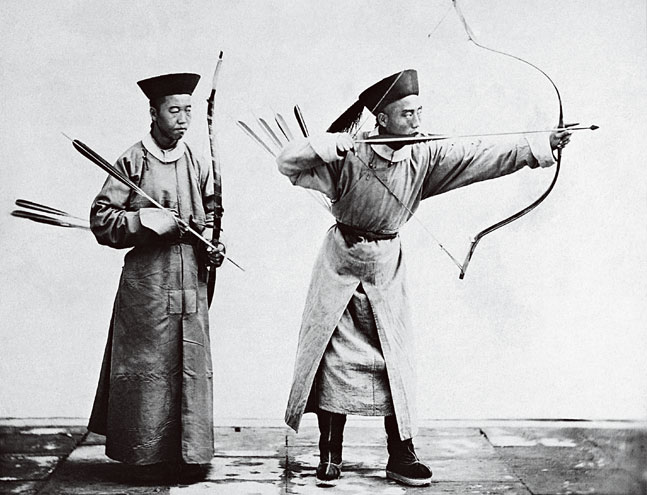After knowing what Manchu is, it's time to move on to the most important thing: how to tackle with the Manchu text. Our lesson today is vowel "a".
簡單說明一下,滿語有六個母音、十九個子音和十個外來子音(又稱特殊子音),為了不嚇壞大家,今天我只讓大家看看六個母音的大概模樣(只是看一下,這課只講母音"a"),其他的在往後的課裡才慢慢講。
Manchu has six vowels, nineteen consonants and ten loan consonants. In order not to scare you away from your learning, let's make it simple by just learning how the six vowels look like (though we will only talk about vowel "a" for today) and let the rest be explained in future lessons.
以下是滿語的六個母音︰
Below is the six vowels of Manchu:
 |
| 摘自河內良弘和清瀨義三郎則府合編的《滿洲語文語入門》第三頁 Taken from Kawachi Yoshihiro and Kiyose Gisaburo Norikura's Introduction to Literary Manchu, p.3 |
從上圖可以看到六個母音及它們在不同位置時的寫法,第一行就是母音"a",我們今天的重點,放大讓大家看清楚。
Form the above image, you can see how the six vowels look like and how they differ when they are in different parts of the word. The first row is our focus of today, vowel "a". you would find a larger image below:
單獨形是它單獨表現時的寫法,語頭形是它作為字首時的寫法,語中形就是字中間時而語末形就是字尾。
The first row is the Romanized form, the second how it looks like when it is on its own; the third when it is placed as word-initial; the forth when it is in the middle and the last when it is at the end of a word.
這樣講很難理解,我們用幾個字來呈現吧!
Let's better explain it with the use of a few words.
語頭形(左是楷書體、右是行書體,中間是羅馬字)︰
Word-initial (Left being the regular script, right the other form while the middle is the Romanized form):
語中形︰
In the middle:
語末形︰
Word-end:
語末形有兩種寫法,左邊第一種緊接子音b, p, k', g', h',右邊第二種緊接其餘子音。
The form for word-end has two variants. The left one follows consonants b, p, k', g' and h' while the right one follows the other consonants.
母音"a"讀音如粵語「呀」,普通話、國語的「阿」。
Vowel "a" sounds as "a" in "Father"。
清朝劇集中的「阿瑪」就是「爸爸」或「爹爹」的滿語了。
So the "Ama" in Qing dramas is "father" and "daddy" in Manchu language.
下一講我們繼續講下一個母音,"e"。
In next lesson, we will talk about vowel "e".
Form the above image, you can see how the six vowels look like and how they differ when they are in different parts of the word. The first row is our focus of today, vowel "a". you would find a larger image below:
 |
| 楷書體 Regular script |
 |
| 行書體 Another form |
單獨形是它單獨表現時的寫法,語頭形是它作為字首時的寫法,語中形就是字中間時而語末形就是字尾。
The first row is the Romanized form, the second how it looks like when it is on its own; the third when it is placed as word-initial; the forth when it is in the middle and the last when it is at the end of a word.
這樣講很難理解,我們用幾個字來呈現吧!
Let's better explain it with the use of a few words.
語頭形(左是楷書體、右是行書體,中間是羅馬字)︰
Word-initial (Left being the regular script, right the other form while the middle is the Romanized form):
 |
| 大 big, great |
語中形︰
In the middle:
 |
| 世 world |
語末形︰
Word-end:
 |
| 阿瑪 大 Father big, great |
語末形有兩種寫法,左邊第一種緊接子音b, p, k', g', h',右邊第二種緊接其餘子音。
The form for word-end has two variants. The left one follows consonants b, p, k', g' and h' while the right one follows the other consonants.
母音"a"讀音如粵語「呀」,普通話、國語的「阿」。
Vowel "a" sounds as "a" in "Father"。
清朝劇集中的「阿瑪」就是「爸爸」或「爹爹」的滿語了。
So the "Ama" in Qing dramas is "father" and "daddy" in Manchu language.
下一講我們繼續講下一個母音,"e"。
In next lesson, we will talk about vowel "e".

No comments:
Post a Comment